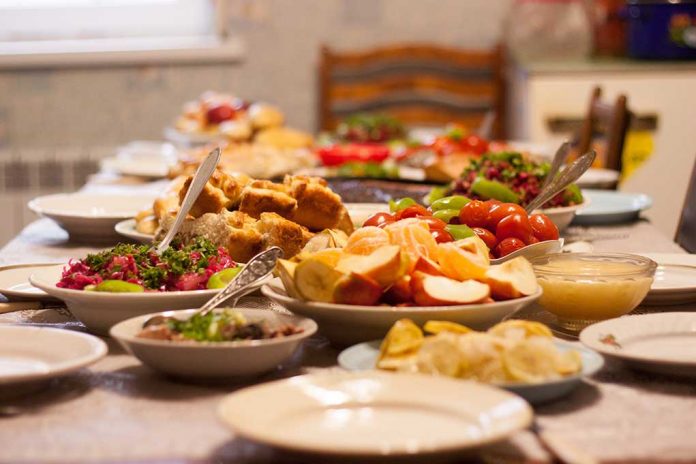You’ve invited the guests, decorated the table and prepared the food. Then the guests are delayed, call to cancel or don’t show at all. Holiday meals and other celebrations require careful planning to ensure that everything goes “just right.” When guests encounter emergencies and the meal must be delayed or cancelled, food must be handled “just right” to remain safe.
Every day the hotline receives calls from consumers who need some help with these unplanned situations. Here’s how to handle the food safely.
Q. I have prepared a special dinner for a group of friends, but I just heard the weather report on TV advising everyone to stay home. What should I do with all the food?
A. If your guests can re-schedule within four days, cooked foods can be stored safely in the refrigerator. For longer storage, freeze any cooked food. Arrange the cooked food in shallow airtight containers or wrap tightly with heavy-duty aluminum foil or freezer wrap, and freeze. These foods will keep their best quality (flavor, texture, juiciness) for 3 to 4 months. Also, most vegetable, rice and pasta dishes can be frozen. Cream sauces may become lumpy or separate when frozen and reheated, but they will be safe to serve again.
Q. I thawed steaks for dinner tonight. Will they need to be discarded if the guests do not come?
A. Raw meat (or poultry) can be safely refrozen, but ONLY if it was thawed in the refrigerator. If the meat or poultry was previously frozen, there may be a decrease in quality when frozen a second time, but it would be safe because bacteria do not grow in the freezer.
Alternatively, if your guests will be able to come at a later time, poultry and ground meats can be refrigerated for two days; red meats like roasts and steaks, up to five days. Kept longer at refrigeration temperatures, meat or poultry will likely spoil.
Q. Everything is ready for the meal but my guests have been delayed at least an hour. What shall I do to hold the food?
A. Remember the basic food safety rules:
- Keep hot foods hot, and cold foods cold.
- Don’t let any cooked food, meat or poultry remain in the danger zone — between 40 °F and 140 °F — for more than 2 hours.
If you have hot foods in the oven, you may be able to hold them safely until your guests arrive. Put a food thermometer in the thickest part of your roast or poultry, or center of your casserole. Adjust the oven temperature so that the food stays at an internal temperature of 140 °F or above. To prevent dryness, cover the dishes or wrap with aluminum foil.
Q. Due to an emergency situation, my guests will be here, but they will be three to four hours late. Can the food stay in the oven?
A. Food will probably dry out if kept warm that long. For extended delays, it is safer to refrigerate the food and reheat it when your guests arrive. Food in shallow containers will cool rapidly to a safe temperature in the refrigerator. Do not worry about putting hot foods directly into the refrigerator because the thermostat will keep the unit running to maintain a safe temperature (40 °F or below). When your guests arrive, reheat food in a 325 °F oven to an internal temperature of 165 °F, or until hot and steaming. Cold foods should be kept refrigerated until mealtime.
Q. My stuffed turkey is ready NOW, and the guests are not arriving for three hours. Help!
A. If you have prepared a turkey and you have determined it is safely done several hours before serving time, remove the turkey from the oven and allow it to stand for 20 minutes. If the turkey is stuffed, remove the stuffing, place it in a shallow container, cover and refrigerate. Remove the legs, thighs, and wings. Carve the breast meat, and legs and thighs, if desired.
If you want to serve the turkey cold, arrange the sliced turkey on platters or in shallow containers. For carved turkey meat to be reheated, place the slices in shallow oven-safe baking dishes or pans. Cover and refrigerate the meat. If you will be making gravy, pour off the drippings and refrigerate them. The gravy can be made at your leisure.
About thirty minutes before serving turkey to be heated, sprinkle with a little broth. Cover with foil and heat in a 325 °F oven. The stuffing can be heated alongside the turkey.
Q. I frequently order take-out foods when I am entertaining. What should I do with the food after I bring it home?
A. How you handle the food will depend on its temperature when you pick it up. First, take the food home immediately. Do not leave take-out foods at room temperature longer than two hours. At room temperatures over 90 °F, discard after one hour.
Foods cold when picked up should be refrigerated until serving time. If the food is hot, and you will not be eating within two hours, keep it in an oven set at a high enough temperature to keep the turkey at 140 °F. Measure the temperature of the turkey by inserting a food thermometer in the thickest part of the thigh. If you are picking up the foods far in advance, refrigerate them and reheat later for serving.














